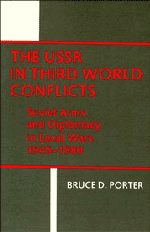Book contents
- Frontmatter
- Contents
- Preface
- 1 Introduction
- 2 The USSR in local conflicts: a historical overview
- 3 Soviet power projection: advances in postwar military capabilities
- 4 The case studies: a framework for analysis
- 5 The Yemeni civil war
- 6 The Nigerian civil war
- 7 The Yom Kippur war
- 8 The Angolan civil war
- 9 The Ogaden war
- 10 Conclusions
- Index
3 - Soviet power projection: advances in postwar military capabilities
Published online by Cambridge University Press: 05 August 2011
- Frontmatter
- Contents
- Preface
- 1 Introduction
- 2 The USSR in local conflicts: a historical overview
- 3 Soviet power projection: advances in postwar military capabilities
- 4 The case studies: a framework for analysis
- 5 The Yemeni civil war
- 6 The Nigerian civil war
- 7 The Yom Kippur war
- 8 The Angolan civil war
- 9 The Ogaden war
- 10 Conclusions
- Index
Summary
As Peter grew older his nursery began to look more and more like an arsenal.
Vasili Klyuchevsky, Peter the GreatIt is not possible for a country to conduct global diplomacy without the military capabilities necessary to project its power for considerable distances beyond its borders. Ray Cline has observed that “unlike economic power, or for that matter strategic-nuclear power, the capability of non-nuclear military forces wanes quite rapidly with distance. Armed forces which could be formidable on home ground, such as those of Switzerland, may have very little capability even a short distance beyond national borders.” After World War II, the Soviet Union had by far the largest standing army in Europe, but this force, though formidable, did not give Moscow much influence over the outcomes of political and military events in the vast majority of the world that was not contiguous or near to the USSR's borders. The Soviet Union was a superpower, but its limited military reach meant that, unlike the United States, it was not a global power.
The Kremlin had managed as early as the Spanish civil war (1936—8) to muster sufficient sealift capabilities to furnish the Loyalist forces with massive quantities of arms, but this had proved a slow and clumsy operation, ultimately futile. Until the late 1960s and early 1970s, Moscow was sorely deficient in those kinds of military forces suitable for rapid and versatile projection of power abroad. This deficiency naturally limited the scope and magnitude of the USSR's involvement in Third World conflicts.
- Type
- Chapter
- Information
- The USSR in Third World ConflictsSoviet Arms and Diplomacy in Local Wars 1945–1980, pp. 36 - 59Publisher: Cambridge University PressPrint publication year: 1984



